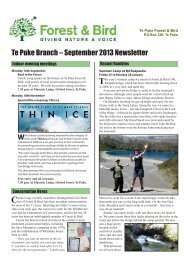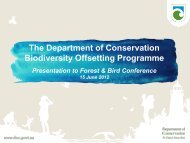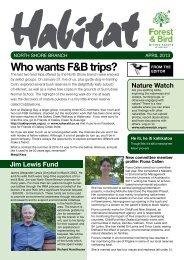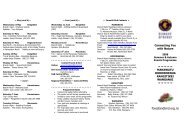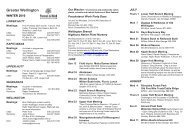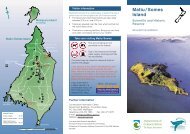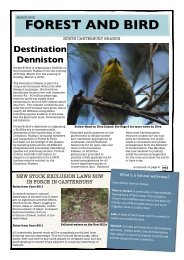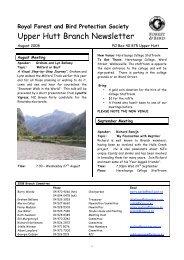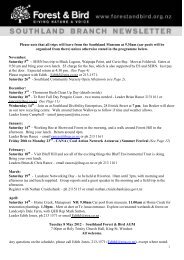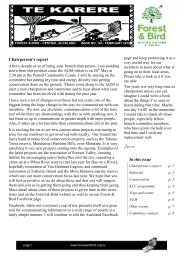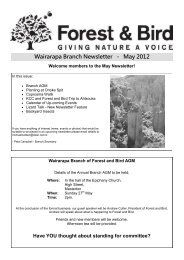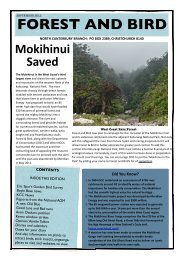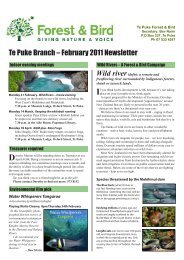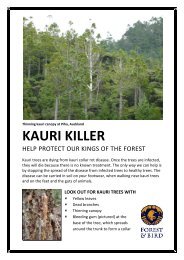gills reserve - Forest and Bird
gills reserve - Forest and Bird
gills reserve - Forest and Bird
You also want an ePaper? Increase the reach of your titles
YUMPU automatically turns print PDFs into web optimized ePapers that Google loves.
WELCOME NEW MEMBERS!<br />
Welcome to these new members, <strong>and</strong> thank you to<br />
those listed who have renewed their sub. We hope to<br />
see you soon at one of our branch activities.<br />
Christina, Joel <strong>and</strong> Kyle Anderson, Diana Bakkerus,<br />
Paul Barton, Michael Bell, Thomas, Fiona <strong>and</strong> Zach<br />
Bendall, Colin <strong>and</strong> Vivienne Bishop, Linda Blincko,<br />
Matt Bowden, Christ Bonham, Stephanie Bristol,<br />
Andrew Brookie, John Brown, Nikola Byrne, Alison<br />
<strong>and</strong> Howard Buxton, Wendy Cain, Frances Cannon,<br />
V F Carlisle, Joanna Crawford, Greg Dearsly, Dorothy<br />
25 Hours on Matiu/Somes Isl<strong>and</strong><br />
Every March, Kiwi Conservation Club<br />
coordinators from all over NZ are invited<br />
to a training weekend. It’s an invaluable<br />
opportunity to learn new <strong>and</strong> effective<br />
ways of presenting conservation messages<br />
to youngsters, <strong>and</strong> to link in with other<br />
coordinators plus staff at Head Office.<br />
<strong>Forest</strong> & <strong>Bird</strong> branches support their KCC<br />
coordinators by reimbursing travel costs;<br />
Head Office pays for accommodation <strong>and</strong><br />
food. Last year three of us drove to Mt<br />
Ruapehu from North Shore. In 2011, I flew to Wellington.<br />
Matiu Isl<strong>and</strong>, in Wellington Harbour, was named by Kupe, after<br />
one of his daughters. Maori occupied the isl<strong>and</strong> for generations.<br />
By 1839, it had become Somes Isl<strong>and</strong> after Joseph Somes,<br />
deputy governor (<strong>and</strong> financier) of the New Zeal<strong>and</strong> Company.<br />
In 1997, the NZ Geographic Board assigned the official bilingual<br />
name of Matiu/Somes Isl<strong>and</strong>. From the early 1870s until 1920,<br />
the 24.8 hectare isl<strong>and</strong> was used as a human quarantine<br />
station. Immigrant ships carrying sick passengers with infectious<br />
diseases had to fly a yellow quarantine flag <strong>and</strong> pass the sick<br />
over. Many died <strong>and</strong> were buried on the isl<strong>and</strong>.<br />
Matiu/Somes also served as an animal quarantine station for<br />
more than 100 years, beginning in the early 1880s. Dogs, cattle,<br />
sheep, red deer, llama <strong>and</strong> other livestock were kept until given<br />
a clean bill of health. Visitors to the isl<strong>and</strong> can now inspect the<br />
empty buildings.<br />
‘Enemy alien internees’ were Italian <strong>and</strong> German migrants <strong>and</strong><br />
their NZ-born children, who were considered a security threat<br />
to NZ in war time. They had to live on the isl<strong>and</strong> during both<br />
world wars. Relics of war include gun emplacements built in<br />
1942, but never used. The Wrens operated a degaussing unit,<br />
demagnetising ships’ hulls so they would not be blown up by<br />
mines placed in the harbour by the Russians.<br />
Numerous groups, including <strong>Forest</strong> & <strong>Bird</strong>’s Lower Hutt branch,<br />
have revegetated the isl<strong>and</strong>, planting taupata, ngaio, hebe<br />
species, tauhinu (cottonwood) <strong>and</strong> harakeke, since 1981. The<br />
Cook Strait weta.<br />
Debenham, Matthew Diesch, Karen Donald, Diana<br />
Douglas, Kylie Ann Dunlop, Janice Dunn, Regina Dunn,<br />
Jinni Easterday, Kim Marie Evans, Roly Ferkins, Raewyn<br />
Ferkins, Brenda Finer, Belvia Frasmus, Andrew Fry, Bill<br />
<strong>and</strong> Noeline Gibson, Dhiyaa Habib, Emma Hawcridge,<br />
Samantha Heazlewood, Carol Hosking, Elizabeth<br />
House, Katherine Instrall, Lindie Jacobs, Shirley Jukic,<br />
Chris Kelly, Hubert Korybut-Woroniecki, Norlin Kuluka,<br />
Sally Laidlaw, H.A Lange, Elizabeth Lorimer, Israel<br />
Machado-Macdonald, Steven Matthews, Daniel<br />
McSweeney, Bryan <strong>and</strong> Marion Merriman, Mrs A Minaar,<br />
Philip Moll, Emily Molloy, B.A Morris, Taianhalo Nati,<br />
Leigh Paine, Belinda Parsons, Lieuarne Ponoho, Davor<br />
Popaditch, Isobel Pope, Sharon Race, Judith Robins,<br />
Natasha Rm<strong>and</strong>ic, Sally Rowan, Carol Russell, Gillian<br />
Ross, Maki Sakamato, Ray Sly, Barbara Smith, Haddon<br />
Smith, Michelle Smith, Jennifer Sol, Joanne Stanford,<br />
Jo Steffen, Vicky Swanson, Kathryn Tarrant, Angela <strong>and</strong><br />
Marc Tinsel, Merissa Rachel Walker, Christina Webb,<br />
Tony White, Teresa M Williams, Keith Wilson.<br />
restored forest now forms a canopy<br />
up to 5m high in places.<br />
The isl<strong>and</strong> was opened to the public<br />
in 1995. It was returned to iwi in<br />
2008 but is still administered by DoC.<br />
East by West Ferries run several trips<br />
each day.<br />
Everyone who visits Matiu/Somes<br />
Isl<strong>and</strong> must first go to the Whare<br />
Kiore. With its doors shut, we were<br />
welcomed <strong>and</strong> given an introduction to the isl<strong>and</strong>’s history <strong>and</strong><br />
rules. A serious self-check exercise of our bags <strong>and</strong> footwear<br />
followed. We had to search every pocket for rats, mice, seeds<br />
<strong>and</strong> even ants. Nobody wants an invasion of Argentine ants like<br />
up north.<br />
Ann Graeme, who has been involved with KCC since the<br />
beginning, <strong>and</strong> KCC officer Jenny Lynch are our leaders. On<br />
this trip we were accompanied by a number of Wellington KCC<br />
coordinators, plus Tim Galloway, illustrator of the much-loved<br />
KCC magazine Wild Things.<br />
We hunted for bugs. A h<strong>and</strong>ful of leaf litter from beneath an<br />
old macrocarpa revealed vastly different wildlife from beneath<br />
native tree species. The emphasis was on putting the creatures<br />
into broad categories: beetles; insects without wings (springtails);<br />
arachnids (spiders); arthropods (millipedes <strong>and</strong> centipedes). KCC<br />
coordinators become like children on bug hunts.<br />
On the circuit track, skinks <strong>and</strong> kakariki were everywhere, <strong>and</strong><br />
it didn’t take long to spot a tuatara (Brothers Isl<strong>and</strong> species).<br />
Pohutukawa have been poisoned (now deemed inappropriate in<br />
that location) to make way for other species which would once<br />
have flourished on the isl<strong>and</strong>.<br />
At dusk we split into small groups to search for korora (little blue<br />
penguin), tuatara <strong>and</strong> Cook Strait giant weta. The sound of korora<br />
filled the night. Their burrows are all over the isl<strong>and</strong>.<br />
Our sharing of ideas <strong>and</strong> feedback on the new design of the KCC<br />
mag was followed by some new ecological games. One of the<br />
most effective ways of making a conservationist is by having fun in<br />
the wild, while at the same time contributing to its enhancement<br />
in some way.<br />
– Margi Keys<br />
PROVERB<br />
Ko te manu e kai ana i te miro, no - na te ngahere.<br />
Ko te manu e kai ana i te ma - tauranga, no - na te ao.<br />
The bird that feeds on the miro berry has the forest.<br />
The bird that feeds on knowledge has access to the world.<br />
Supplied by Christine Ball



